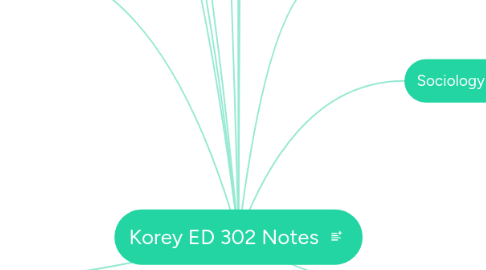Korey ED 302 Notes
by Korey Cowart


1. Politics of Education
2. History of Education
2.1. The first public high school was opened in Boston in 1821.
2.2. Schools were separate but not equal, until the Brown vs Board of Education
2.3. 1983- A Nation at Risk (ANAR) was released by Ronald Reagan.
2.4. 2002-The No Child Left Behind Act (NCLB) was passed by George W. Bush
3. School Organizations
3.1. Schools are separate social organizations due to factors such as population, social relationship, political structure, etc.
3.2. No Child Left Behind has influenced our school system. Hold a college degree, certification in field of study, and knowledge of academic content in their field.
3.3. Finland is number one in education. America is number 17.
3.4. We are not under a centralized government such as these other countries. They receive what they are to teach from the government, such as a "script" to teach.
3.5. The other countries also go to school longer or are trained better in education. Teachers in Finland, are also put through a longer and more advanced curriculum.
4. Curriculum
4.1. Traditional approaches view curriculum as objective bodies or knowledge in which this knowledge may be designed, taught, and evaluated.
4.2. The four types of curriculum are Humanist, Developmentalist, Social Efficiency, and Social Meliorist.
4.3. Humanist is based on idealist philosophy that liberal arts is the basis of education
4.4. Social Efficiency believes different groups have different needs and should receive different types of education to meet specific needs.
4.5. Developmentalist is based on progressive educational practices.
4.6. Social Meliorist is based on social reconstructionist theory that schools should work to change society and help solve fundamental social problems.
5. Equality Opportunities
5.1. Caste Stratification- occurs in agrarian societies where social level is defined in terms of some strict criteria such as race or religion.
5.2. Estate stratification- occurs agrarian in societies where social level is defined in terms of the hierarchy of family worth
5.3. Class Stratification- occurs in industrial societies that define social level in terms of a hierarchy of differential achievement by individuals, especially in economic pursuits.
5.4. Upper Class: 1-3% of the population; Upper Middle Class: 15% of the population; Lower Middle Class: 25% of the population; Working Class: 40% of the population; Underclass/Lowerclass: 20% of the population
5.5. Coleman's Report was designed to help identify the characteristics of schools which did matter so that the impact of school relative to that of family could be increased.
5.6. Coleman's work was oft misinterpreted as an argument that school's don't matter, only families matter.
6. Explanations of Educational Inequality
6.1. Functionalist Vision of a "just society" is one where individual talent and hard work are based on universal principles of evaluation.
6.2. Functionalists expect that the process of schooling will produce unequal results, but that the results due to individual differences between students, not on group differences.
6.3. Interactionist theory suggests that we must understand how people within institutions such as families or schools interact on a daily basis
6.4. Student Centered or Extra School explanations of inequalities focus on factors outside of school such as family, the community, culture, peer groups and the individual student.
6.5. Characteristics of Effective Schools: High expectations for students by teachers AND administrators. Strong, effective leadership by school administration. Accountability processes for both students and teachers. Close monitoring of student learning. A high degree of instructional time on task. Flexibility for teachers to adapt to new situations and solve problems.
6.6. There are 3 Controversial Perspectives: Genetic or Biological Differences Theory, Cultural Deprivation Theories, and Cultural Difference Theory
7. Educational Reform
7.1. The First Wave: Stressed the need for increased education excellence through increased educational standards.
7.2. Focus was on: equity in schools, goals, common core curriculum, eliminate tracking programs, vocational, technology education, duration and intensity of academic learning, training teachers better
7.3. Second Wave: Recommendations made at the State Governor's Conference.
7.4. Focus on: Teaching leadership and management, parental involvement, student readiness, school facilities utilized, accountability for learning, teacher programs lacked rigor, recognizing academic components of tep, attract competent teacher candidates.
7.5. Goals 2000
7.6. Goal 1: All children will start school ready to learn.
7.7. Goal 2: High school graduation rates will increase to at least 90%
7.8. Goal 3: Students will leave grades 4, 8, and 12, having demonstrated competency in challenging subject matter.
7.9. Goal 4: U.S. students will be first in the world in math and science achievement.
7.10. Goal 5: Every adult American will be literate and will possess the skills necessary to compete in a global economy.
7.11. Goal 6: Every school in America will be free of drugs and violence and will offer a disciplined environment conducive to learning.
8. Foundations of Education
8.1. 4 Issues in Education
8.1.1. Poverty in Schools
8.1.1.1. Socio-economic
8.2. Assessment Issues
8.3. School Funding
9. Philosophy of Education
10. Neo-Liberal
10.1. Critique traditional ideas and ways
10.2. Combines liberal and conservative thoughts and ideas
10.3. See that educational failures come from the way things are handled with the educational systems
10.4. Teachers being kept around due to favoritism or social standing with the school; Letting go of the newest teacher, regardless of level of excellence, but keeping others based off of tenure
11. Sociology of Education
11.1. Societal Level
11.1.1. Structre of Dominance in Society; Societal Ideologies
11.2. Institutional Level
11.2.1. Educational Structures
11.3. Interpersonal Level
11.3.1. Teacher's Expectations; Educational Interactions
11.4. Intrapsychic Level
11.4.1. Educational Outcomes
11.4.2. Cognitive
11.4.3. Non-cognitive
